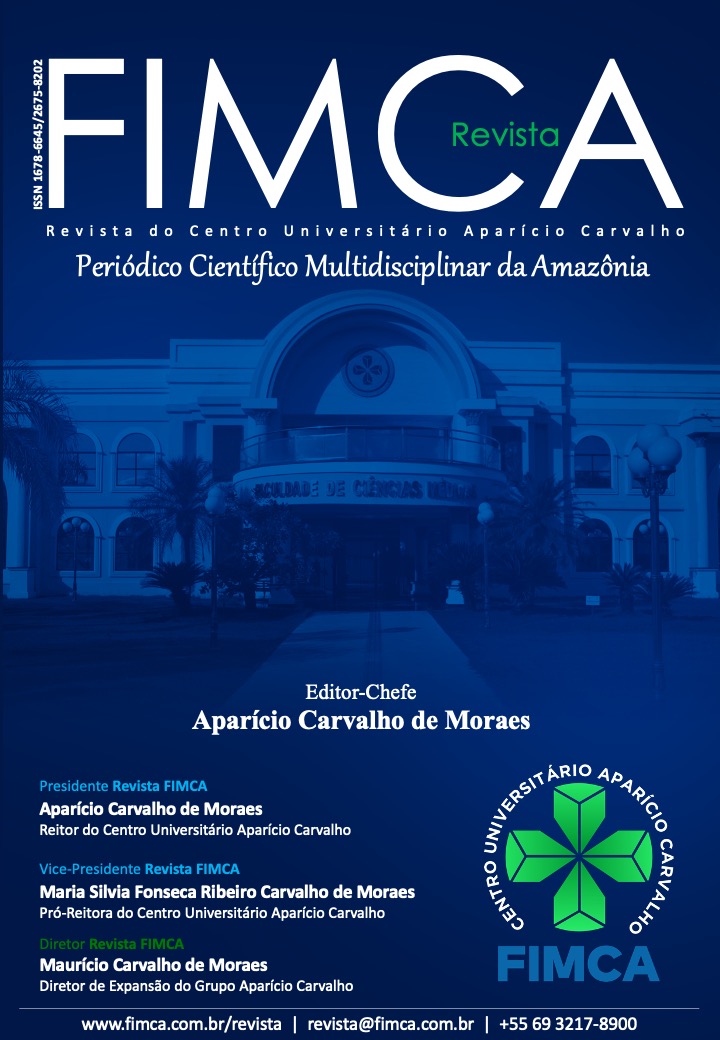REABILITAÇÃO BUCAL EM ODONTOPEDIATRIA: RELATO DE CASO
ORAL REHABILITATION IN ODONTOPEDIATRY: CASE REPORT
DOI:
https://doi.org/10.37157/fimca.v9i1.241Palavras-chave:
Avulsão dentária, Reimplante dentário, Traumatismos dentários, Odontologia preventiva, Estética DentáriaResumo
Introdução: Os traumatismos dentários são um problema de saúde pública. Atualmente, com a redução mundial do índice de cárie eles representam a maior necessidade de tratamento para dentes anteriores. Quando não tratados eles podem causar impactos físicos, estéticos, sociais e psicológicos e interferirem negativamente na qualidade de vida de crianças e adolescentes. Relato de caso: O presente trabalho tem por objetivo relatar um caso clínico de reabilitação bucal em Odontopediatria, após o insucesso do reimplante dentário tardio, de dois incisivos centrais superiores permanentes, de uma menina de oito anos de idade. Devido ao avanço da reabsorção radicular externa dos dentes reimplantados a exodontia foi realizada e a paciente reabilitada com mantenedor de espaço ortodôntico móvel, visando devolver à estética e a função. O caso está em acompanhamento devido à troca de dentição, crescimento e desenvolvimento crânio facial. No futuro, uma correção ortodôntica e reabilitação protética implanto suportada será necessária. Discussão: A avulsão dentária é o traumatismo mais comum na dentição permanente. O reimplante, quando bem indicado e seguindo orientações dos protocolos disponíveis na literatura, possui bom índice de sucesso, mas em muitos casos a perda dentária é inevitável. Nestes casos, a reabilitação restabelecer a estética dentária representa um ganho estético, funcional e qualidade de vida das crianças. Conclusão: Este relato de caso oferece uma opção de reabilitação bucal em odontopediatria nos casos de perda precoce de incisivos permanentes. Com base nos conhecimentos encontrados na literatura e no presente relato de caso, o sucesso terapêutico do reimplante dentário é mais alto quando os protocolos e guidelines são aplicados na prática clínica. Educação e prevenção são as melhores maneiras de evitar o traumatismo dentário.
Introduction: Dental injuries are a public health problem. Currently, with the worldwide reduction of the caries index, dental injuries can be considered the biggest cause of the need for treatment of anterior teeth. Untreated dental trauma can cause physical, aesthetic, social, and psychological impacts and negatively affect the quality of life of children and adolescents. Case report: The present study aims to report a clinical case of oral rehabilitation in pediatric dentistry in an eight-year-old girl with a history of failure in the late dental replantation of two permanent upper central incisors. As a result of advanced external root resorption of the reimplanted teeth, extraction was performed and the patient was rehabilitated with a mobile orthodontic space maintainer, restoring aesthetics and function. The case is being monitored due to exchange of dentition, craniofacial growth and development. In the future, orthodontic correction and implant-supported prosthetic rehabilitation will be necessary. Discussion: Tooth avulsion is the most common trauma to permanent dentition. When well indicated, reimplantation following the guidelines of the protocols available in the literature has a success rate, although tooth loss is inevitable in many cases. In these cases, the rehabilitation represents an aesthetic, functional, and quality of life gain. Conclusion: This case report offers an oral rehabilitation option in pediatric dentistry in cases of early loss of permanent incisors. Based on the knowledge found in the literature and the present report, therapeutic success is higher when the protocols and guidelines are in practice. Anticipatory guidance and preventive counseling are the best ways to prevent dental trauma.
Referências
ADNAN, S. et al. Which is the most recommended medium for the storage and transport of avulsed teeth? A systematic review. Dental Traumatology, v. 34, n. 2, p. 59-70, 2018. <https://doi.org/10.1111/edt.12382>.
ALDRIGUI, Janaina Merli et al. Trends and associated factors in prevalence of dental trauma in L atin A merica and C aribbean: a systematic review and meta?analysis. Community dentistry and oral epidemiology, v. 42, n. 1, p. 30-42, 2014.
ANDERSSON, L. Epidemiology of traumatic dental injuries. Journal of endodontics, v. 39, n. 3, p. S2-S5, 2013. <https://doi.org/10.1016/j.joen.2012.11.021>.
ANDREASEN, J. O; ANDREASEN, F. M. Texto e atlas colorido de traumatismo dental. Artmed, 2001. 778 p.
BOMFIM, R. A.; HERRERA, D. R.; DE-CARLI, A. D. Oral health-related quality of life and risk factors associated with traumatic dental injuries in Brazilian children: A multilevel approach. Dental Traumatology, v. 33, n. 5, p. 358-368, 2017. <https://doi.org/10.1111/edt.12348>.
BORGES, T. S. et al. Impact of traumatic dental injuries on oral health-related quality of life of preschool children: A systematic review and meta-analysis. Plos One, v. 12, n. 2, p. 1-13, 2017. <https://doi.org/10.1371/journal.pone.0172235>.
BÜCHER, K. et al. Complications and survival rates of teeth after dental trauma over a 5-year period. Clinical oral investigations, v. 17, n. 5, p. 1311-1318, 2013. <https://doi.org/10.1007/s00784-012-0817-y>.
De SANT’ ANNA, G. R. et al. Reabilitação bucal integral e estética em odontopediatria. In DUARTE, D., FERES. M., FONTANA, U.F. Odontopediatria: estado atual da arte: educação, diagnóstico e intervenção estético-funcional. Nova Odessa- SP, Ed. Napoleão, 2018, 368 p.
FELDENS, Carlos Alberto; KRAMER, Paulo Floriani; FELDENS, Eliane Gerson. Exploring the profile of articles on traumatic dental injuries in pediatric dental journals. Dental traumatology, v. 29, n. 3, p. 172-177, 2013.
FILSTRUP, S. L. et al. Early childhood caries and quality of life: child and parent perspectives. Pediatric dentistry, v. 25, n. 5, p. 431-440, 2003.
FINUCANE, D.; KINIRONS, M. J. External inflammatory and replacement resorption of luxated, and avulsed replanted permanent incisors: a review and case presentation. Dental Traumatology, v. 19, n. 3, p. 170-174, 2003. <https://doi.org/10.1034/j.1600-9657.2003.00154.x>.
FOUAD, A. F. et al. International Association of Dental Traumatology guidelines for the management of traumatic dental injuries: 2. Avulsion of permanent teeth. Dental Traumatology, v. 36, n.1, p. 331-342, 2020. <https://doi.org/10.1111/j.1600-9657.2012.01125.x>.
HINCKFUSS, S. E.; MESSER, L. B. An evidence-based assessment of the clinical guidelines for replanted avulsed teeth. Part I: timing of pulp extirpation. Dental Traumatology, v. 25, n. 1, p. 32–42, 2009a. <https://doi.org/10.1111/j.1600-9657.2008.00727.x>.
HINCKFUSS, S. E.; MESSER, L. B. An evidence?based assessment of the clinical guidelines for replanted avulsed teeth. Part II: prescription of systemic antibiotics. Dental Traumatology, v. 25, n. 2, p. 158-164, 2009c. <https://doi.org/10.1111/j.1600-9657.2008.00736.x>.
HINCKFUSS, S. E.; MESSER, L. B. Splinting duration and periodontal outcomes for replanted avulsed teeth: a systematic review. Dental Traumatology, v. 25, n. 2, p. 150-157, 2009b. <https://doi.org/10.1111/j.1600-9657.2008.00761.x>.
KRAMER, P. F. et al. Exploring the impact of malocclusion and dentofacial anomalies on the occurrence of traumatic dental injuries in adolescents. The Angle Orthodontist, v. 87, n. 6, p. 816-823, 2017. <https://doi.org/10.2319/041417-258.1>.
MARCENES, W.; ALESSI, O. N.; TRAEBERT, J. Causes and prevalence of traumatic injuries to the permanent incisors of school children aged 12 years in Jaraguá do Sul, Brazil. International dental journal, v. 50, n. 2, p. 87-92, 2000. <https://doi.org/10.1002/j.1875-595X.2000.tb00804.x>.
PETTI, S. Over two hundred million injuries to anterior teeth attributable to large overjet: a meta?analysis. Dental Traumatology, v. 31, n. 1, p. 1-8, 2015. <https://doi.org/10.1111/edt.12126>.
PRATA, T. H. C. et al. Etiologia e frequência das injúrias dentárias traumáticas em pacientes do Centro de Traumatismos Dentários da Faculdade de Odontologia de São José dos Campos-UNESP. Revista de Odontologia da UNESP, v. 29, n. 1-2, p. 43-53, 2013.
RODRIGUES, T. L. C.; RODRIGUES, F. G.; ROCHA, J. F. Avulsão dentária: proposta de tratamento e revisão da literatura. Revista de Odontologia da Universidade Cidade de São Paulo, v. 22, n. 2, p. 147-153, 2017.
SANTOS, K. S. A. et al. Tratamento de traumatismos dentoalveolares e reabilitação protética em paciente jovem-relato de caso. Odontologia Clínico-Científica (Online), v. 9, n. 2, p. 181-184, 2010.
SCHEFFEL, Débora Lopes Salles et al. Esthetic dental anomalies as motive for bullying in schoolchildren. European journal of dentistry, v. 8, n. 01, p. 124-128, 2014.
SOARES, T. R. C. et al. Risk factors for traumatic dental injuries in the Brazilian population: A critical review. Dental traumatology, v. 34, n. 6, p. 445-454, 2018. <https://doi.org/10.1111/edt.12439>.
ZAROR, Carlos et al. Impact of traumatic dental injuries on quality of life in preschoolers and schoolchildren: A systematic review and meta?analysis. Community dentistry and oral epidemiology, v. 46, n. 1, p. 88-101, 2018.
Publicado
Como Citar
Edição
Seção
A Revista FIMCA disponibiliza seus artigos e resumos para livre acesso de forma permanente e gratuita nos termos da Creative Commons Attribution License, permitindo que a sociedade possa compartilhar (copiar e redistribuir o material em qualquer suporte ou formato para qualquer fim, mesmo que comercial) e adaptar (remixar, transformar, e criar a partir do material para qualquer fim, mesmo que comercial), desde que seja dado o devido crédito apropriado, provendo um link para a licença e indicar se mudanças foram feitas.
Vale a pena ressaltar, que mesmo que o material seja transformado, modificado, ou der origem a outro material, este deve ser distribuido respeitando obrigatoriamente a citação do original nos termos da licença CC BY-AS 4.0 DEED.

















